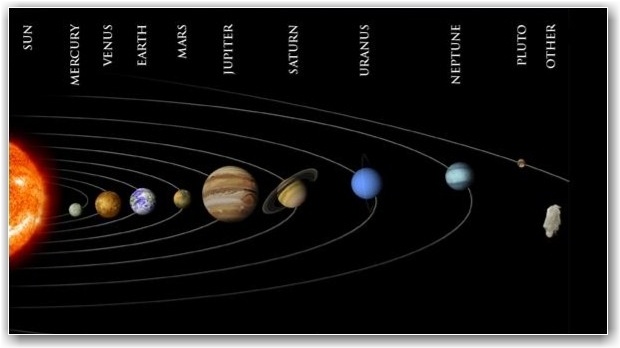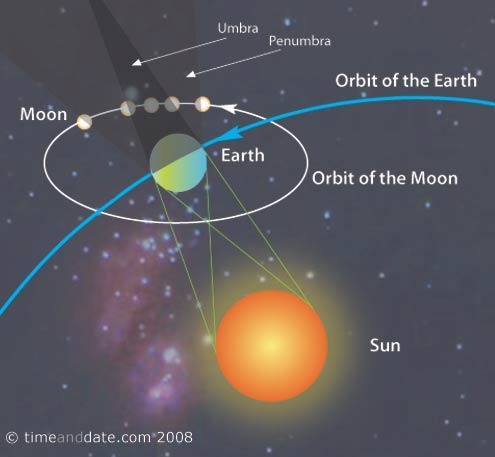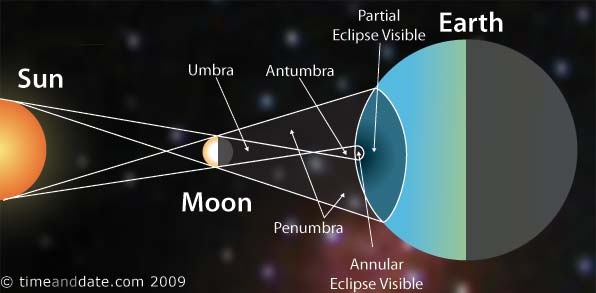The huge limitless space, with planets, satellites, asteroids, comets and billions of stars and other heavenly bodies in it is called the Universe. The space with heavenly bodies that we see through powerful telescopes or with our naked eyes is just a tiny part of The Universe. According to the theory of "Big Bang", the Universe started as result of a big explosion or "Big Bang". Before the explosion there was only a compact mass of stardust or a kind of original substance. We cannot predict the exact age of the Universe.
Scientists are of the opinion that the Solar system came into being around 4.7 billion years ago.
The Solar System is the name given to the Sun and the nine planets including our Earth that move around it. The Sun is the centre of the Solar System.

The Sun is the main source of energy i.e. light and heat. Our Earth would be a dead planet without the Sun.
The nine planet of the Solar System are listed below according to their distance from the Sun.
(1) Mercury (2) Venus (3) Earth
(4) Mars (5) Jupiter (6) Saturn
(7) Uranus (8) Neptune (9) Pluto
Following are the main points of the Planets of Solar System.
1. Mercury
(i) Mercury is the nearest planet to the Sun.
(ii) Mercury is the smallest planet in the Solar System.
(iii) It is at a distance of 57.90 million kilometers from the Sun.
(iv) Its diameter is 4990 kilometers.
(v) It has no Satellite.
(vi) It revolves round the Sun in 88 days.
(vii) Being nearest to the Sun it is very hot.
2. Venus
(i) It is the closest planet to our Earth.
(ii) Its diameter is 12112 kilometers.
(iii) It is at distance of 108.23 million kilometers from the Sun.
(iv) It has no satellite.
(v) Its revolves around the Sun in 225 days.
3. Earth
(i) It is the only planet in the solar system where different kind of like exists.
(ii) Its diameter is 12756 kilometers.
(iii) It is at a distance of 149.60 kilometers from the sun.
(iv) It has one satellite i.e. the moon.
(v) It revolves round the sun in 365 days and six hours.
4. Mars
(i) It is at a distance of 227.70 million kilometers away from the Sun.
(ii) Its diameter is 6760 kilometers.
(iii) It has two satellites.
(iv) It revolves around the Sun in 322 days.
(v) There are patches of ice on its North and South Poles.
5. Jupiter
(i) Its diameter is 142700 kilometers.
(ii) Its is the largest planet of the Solar System.
(iii) It is at a distance of 778.12 million kilometers from the Sun.
(iv) It has 16 satellites.
(v) It revolves around the Sun is 11 years.
6. Saturn
(i) Its diameter is 114310 kilometers.
(ii) It is at a distance of 1425 million kilometers from the sun.
(iii) It has 19 satellites.
(iv) It revolves around the Sun in 29 years and 168 days.
(v) It is the most beautiful planet in the Solar System and is thus called "Red Star".
7. Uranus
(i) Its diameter is 52,200 kilometers.
(ii) It is at a distance of 2873 million kilometers from the Sun.
(iii) It has 17 satellites.
(iv) It revolves around the Sun in 84 yeas.
(v) It is four times larger than our Earth.
8. Neptune
(i) Its diameter is about 49,500 kilometers.
(ii) It is at a distance of 4498 million kilometers from the Sun.
(iii) It has eight satellites.
(iv) It revolves around the Sun in 165 years.
(v) This planet can only be seen through a telescope.
9. Pluto
(i) Its diameter is 2650 kilometers.
(ii) It is at a distance of 5910 million kilometers form the Sun.
(iii) It has one satellite.
(iv) It revolves around the Sun in 248 years.
(v) It is the smallest planet in the Solar System.
Like Earth, the moon also receives light and heat from the Sun. the surface of the Moon is round and rocky. The rocks being lighter in weight than the rocks of the Earth. The surface is dotted with craters. There is no air and water on it.
The Moon revolves both round the Earth and the Sun, but this revolution has been so designed by nature that we always see the same face of the Moon. The Moon is the only natural satellite of the Earth about which it revolves at a mean distance of 384000 kilometers. Moon's motion is clockwise, but because the Earth rotates in the same direction at a much greater speed, the Moon's apparent daily motion is clockwise. Its movement causes Lunar and Solar Eclipses.
When the Earth comes between the Sun and the Moon, the rays of the Sun are obstructed and the moon becomes dark. It does not look clear. 
This condition is called "Lunar Eclipse".
When the Moon comes between the Earth and the Sun the rays of the Sun cannot reach to the Earth and the Sun is not seen.
This is called solar Eclipse.
A faint band of light across the sky is known as the milky way. If we look with the help of a telescope we will see hundreds of thousands of faint distant stars which appear like bright dust in the sky.



